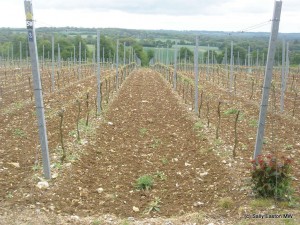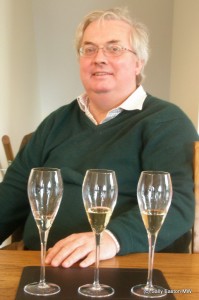Hattingley Valley

South-facing Hattingley vineyard
I feel a bit like I’ve been waiting for new English sparkling wine brand Hattingley Valley to emerge onto the market for quite a while. Firstly it’s just down the road from me, so it’s grown into my local scenery, and secondly, in 2011, I judged the Wessex wine competition in the more than half-built winery site that was becoming the tasting and event rooms. In fact, the winery was functioning just in time for the 2010 vintage.
Even back then the branding was well-established. The wines’ signature silver-washed fritillary was in place, including on the stainless steel vats in the winery. It’s an orange butterfly found across parts of southern England, but it gets its name from the undersides of its wings being ‘washed’ with silver threads.
Hattingley Valley owner Simon Robinson started diversifying his arable farm (Kings Farm, which has lent its name to the estate cuvée) with his first vineyards being planted in 2008 – some ten hectares planted to the classic Champagne trilogy of chardonnay, pinot noir and pinot meunier. Three years later he added another four hectares. He’s also got a bit of chenin blanc, pinot grigio and bacchus to keep him and his team occupied with exploring what else might work on the site, which faces south and overlooks the Watercress Line in the distance.

Simon Robinson
Robinson’s business model for his sparkling wine is akin to that in France’s Champagne region, with some fruit coming from his own vineyards, and other fruit being bought in from more than a dozen growers, mostly from across southern England.
His interest in wine started at university then rested until he was well established in a city law firm. Now, five years into his “project of passion”, he has only just become a full time grower, which is quite timely as the very first vintage of Classic Cuvée is about to released onto the market in all its attractively understated livery.
Winemaker Emma Rice is a fan of oak, and this provides Hattingley Valley with something of a unique selling point in England. Rice said “I like using barrels. It’s a point of difference as very few people in the UK are using oak” in sparkling wine. It’s not new oak, and only about 10% of the harvest is fermented to base wine in these older oak barrels. Rice said “you get a bit of colour” which could be something of another difference, “as English sparklers can be very pale”, she added.
Hattingley Valley will be released onto the market at the end of August. Robinson is pitching it right up there at around £30, which is top-end for a UK sparkler. Here’s my probably not-very-sneak preview:
Tasting, in situ, May 2013
Hattingley Valley, Classic Cuvée, 2010
65% chardonnay with rest from pinot noir and pinot meunier. Eight months on lees in tank plus 18 months on lees in bottle. Dosage 9g/l.
An un-noticeable 10% oak in this cuvee. Pale lemon colour with attractive, bright, green tints. Citrus, apple, elderflower nose, hints of hedgerow. Palate attack is remarkably soft, and easy to appreciate, possibly a hint of roundness from that small oak proportion? It has an effortless, fresh balance, with the focus on fresh fruits – citrus, apple compote, with some fresh-baked bread notes mid palate and elderflower coming in on the finish, giving it decent complexity and palate length. The mousse is delicate and persistent. This is tasty and more than drinkable.
Hattingley Valley, Kings Cuvée, 2010
This cuvée comes from estate fruit only, and is fermented 100% in barrel, giving it particular flavour influences. Just one barrel was made in 2010, so it’s something of a specialty. Eight months in barrel on lees plus 18 months in bottle on lees. Dosage 10g/l.
Lemon, straw colour, with richly toasted nose, lemon-honey and nougat. The palate attack is creamy and vanilla-honeyed, warmly textured, with intense savoury almond and roasted cobnut notes creating a less refreshing mid palate feel. I might think this is a bit savoury and full-bodied to serve as an aperitif – the style is creamy, nutty, complex quite full bodied, with a fine mousse and a long savoury finish. Definitely good quality, and not my personal preference. I’d happily quaff the Classic Cuvée though.
There is also a 2010 blanc de blanc, which is being kept on lees for about another year, because Rice says it needs to fill out and take on more lees ageing characters.



